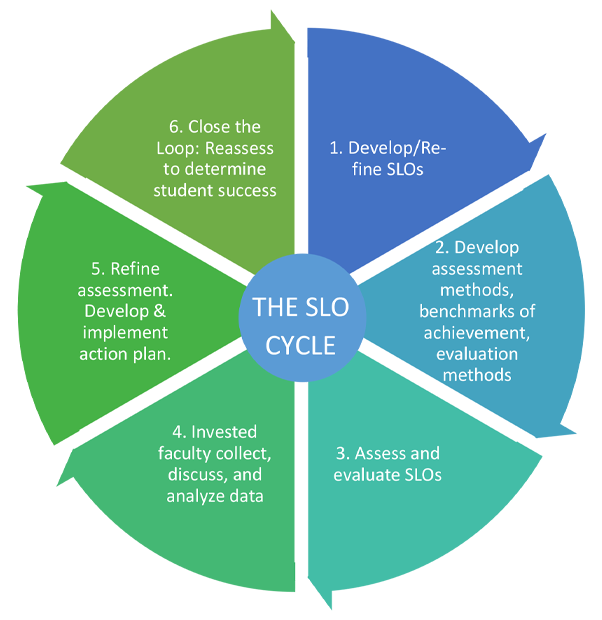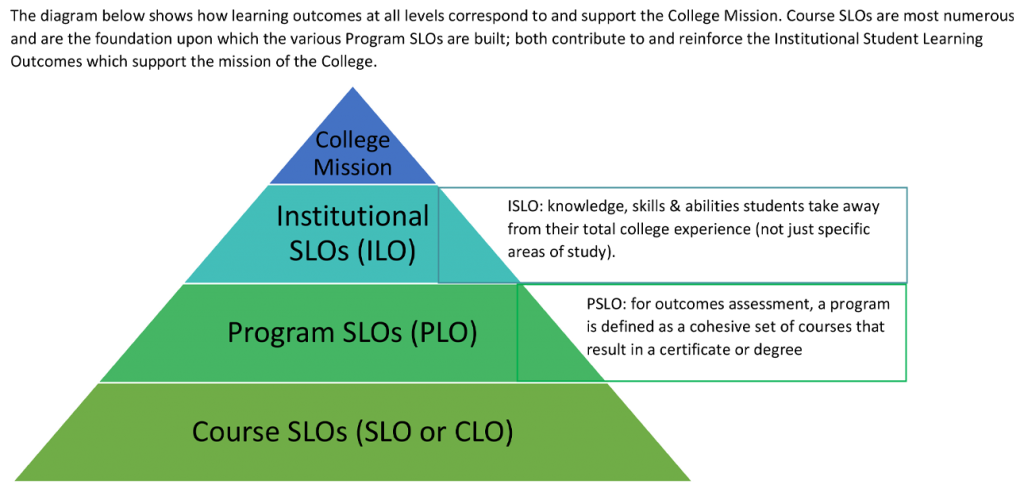What is an SLO?
A Student Learning Outcome (SLO) is a succinct statement of the skills, competencies, and ideas students should be able to articulate, put into action or utilize after the completion of a course. SLOs are scored through student assessments and the student performance is improved through a program improvement process that incorporates multiple data points.
Accreditation agencies introduced Student Learning Outcomes at the turn of the last century as a way to bridge internal academic practices and external expectations for clear information about what students and graduates know and can do. Assessment of well written SLOs provides:
- a statement of the learning opportunities of a given course or program
- data on how to improve instructional programs
- the transferable skills, knowledge, and attitudes of a student
Why are SLOs important?
Student Learning Outcomes allow students to think and talk about what they have learned. They make it easier for students to “know what they know” and give students a language to communicate what they know to others.
Assessing outcomes also helps provide more individualized learning paths for diverse groups of learners, provides valuable information to support economic and labor market needs, and improves the quality of education.
What is eLumen?
The most challenging aspect of academic assessment is collecting data. With eLumen software, collecting data for assessment embeds seamlessly into the process of day-to-day teaching and learning.
NOCE uses eLumen software to centrally manage assessment projects using flexible rubrics and to collect evidence through multiple methods. This data allows assessment to become part of the continuous improvement plan.
Student Learning Outcomes Annual Report
Check out this year’s annual report.
Guiding Principles for SLO Assessment
2010, the Academic Senate for California Community Colleges published the Guiding Principles for SLO Assessment. NOCE uses these 11 principles to guide our Student Learning Outcome Assessment processes.
Principle One:
Faculty are primarily responsible for developing assessment tools and determining the uses of data collected; therefore, faculty engagement and active involvement in SLO assessment is essential.
Principle Two:
Outcomes assessment is a process that should involve all appropriate participants at each level of the college, not just select groups or individuals.
Principle Three:
SLOs and SLO assessments should be connected to the college’s overall culture through the college vision or values statement, program review processes, and college curriculum, planning, and budgeting process.
Principle Four:
SLOs should be clearly mapped and aligned throughout a course sequence and among various levels (course, program, institution) to achieve the most efficient and effective assessment.
Principle Five:
SLO assessment should be as authentic as possible and minimally intrusive to students’ educational experience and the faculty’s instructional planning and performance.
Principle Six:
Rather than relying on one assessment method for all situations, effective assessment may benefit from a variety of methods, even within a single course, that can respond to different learning outcomes, teaching styles, and student learning needs.
Principle Seven:
Assessment data do not exist in a vacuum and must be analyzed alongside all other factors that may impact the achievement of outcomes.
Principle Eight:
SLO Assessment processes and grading are different but mutually compatible activities and should complement rather than conflict with each other.
Principle Nine:
Effective outcomes assessment requires a college commitment of sufficient staff and resources.
Principle Ten:
SLO assessment of student learning outcomes is a process that is separate from faculty evaluation.
Principle Eleven:
Faculty should engage in SLO development and assessment not because it is a requirement for accreditation but rather because it is a good professional practice that can benefit programs and students.
SLO Frequently Asked Questions (FAQ)
We understand there might be questions regarding the SLO process, its importance, and its implementation. Here’s a compiled list of frequently asked questions to provide clarity. Here is the PDF SLO FAQ version if you wish to print this resource.
-
What is an SLO?
An SLO, or Student Learning Outcome, is a clear and concise statement that describes how students can demonstrate their mastery of the learning objectives of a course or program.
-
Why is SLO assessment important?
SLO assessment is crucial as it offers insights into student learning, enhancing instructional strategies. It serves as a metric to gauge the effectiveness of a course or program and pinpoint areas for improvement.
Notably, most students who completed their courses in 2021/22 met the SLOs, with most achieving an average score of 70% or higher.
-
How do I assess an SLO?
SLO’s can be assessed through various methods, including:
Rubric Assessment: Using a final essay, portfolio, or project to evaluate all the course SLOs. It’s particularly effective in disciplines where students progressively build on skills throughout the course.
Observation: This method involves an observational skill assessment where instructors or peers observe and evaluate a student’s performance or behavior in real-time situations.
Chapter Quizzes and Unit Tests: These are standard methods to assess SLOs, with scores being reported each semester.
-
When should I assess an SLO?
To ensure continuous improvement in student learning, SLO’s should be assessed regularly. This assessment takes place every term for every class.
-
How do I interpret the SLO assessment data?
Once you’ve entered your assessment scores into platforms like eLumen, you should review the collective results. This analysis will highlight areas where students are thriving and areas where additional support might be beneficial.
Consider overall trends, patterns, outliers, and comparisons in the data. For instance, are there consistent differences in performance between terms? Are there data points that deviate significantly from the norm?
Break down data by subgroups, such as ethnicity, to see if trends or patterns change significantly between subgroups.
When analyzing narrative information, like survey comments, look for recurring themes and understand common issues or evaluations.
-
What resources are available for SLO assessments?
The school offers a plethora of resources, such as:
Leadership Team: They provide guidance and support throughout the SLO assessment journey.
Associate Deans: Each program boasts an associate dean equipped to assist with SLO-related inquiries.
SLO Coordinator: This dedicated individual oversees the SLO processes as a valuable resource.
Departmental SLO Representatives: Designated Faculty members with expertise in SLOs and a deep understanding of their respective programs. These representatives ensure that each program’s unique needs and perspectives are considered in broader SLO discussions and decisions and support the faculty within their program.
NOCE Canvas Resources: This provides information on what an SLO is, how to assess one, the setup process, and the diverse assessment options (portfolio, test, visual, etc.).
-
Data analysis Tips for SLOs
- Trends: Look for overall trends in data over time and consider factors influencing these trends.
- Patterns: Identify patterns in the data and recognize any surprising concentrations.
- Outliers: Be vigilant for data points that deviate significantly from the norm.
- Comparisons: Compare data with institution-wide data or other benchmarks.
- Data Breakdowns (Disaggregation): Consider data broken down by subgroups, such as ethnicity.
- Themes and Interactions: Analyze narrative information for recurring themes.
-
What is the relationship between Competency-Based Education (CBE) and SLOs?
CBE and SLOs share a close alignment in their foundational principles. Both underscores demonstrated skills and knowledge, outcome-driven goals, learning flexibility, tailored instruction, continuous assessment, and alignment with real-world skills. As the state contemplates transitioning to competency-based education, SLO data will become increasingly pivotal.
-
Who is responsible for SLO’s at our school?
The responsibilities for SLO’s are collective. While faculty play a central role in SLO assessment, everyone contributes to its success, from administrators to support staff.
The contract stipulates the creation and assessment of SLOs for every class each term and accentuates faculty involvement in SLO creation and evaluation. However, it explicitly states that SLO assessment data related to student performance will not factor into the faculty member’s evaluation process.
-
How can I get more involved in the SLO assessment process?
To immerse yourself in the SLO assessment process, participate in department meetings, collaborate with peers, and attend training sessions. Engage in SLO discussions and share your insights and experiences with others.



More information?
Download the SLO infographics in PDF form.
